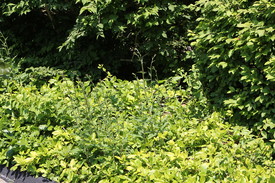 Groundcovers benefit from being clipped back. |
A pleasing green carpet can be achieved with ground covers. They don’t need constant care once they’re established and most are almost self-sustaining if decent soil and adequate water are available. All ground covers, however, absolutely require a yearly weeding, usually during later spring and certainly by June. Ground covers also occasionally need water during droughts or when their leaves wilt and drop.
In very dry or cold locations, ground covers should not be raked clean, for the decaying leaves underneath return nutrients to the soil. In most tropical areas, however, fallen leaves and debris may become rank and unattractive, so occasional light raking out is beneficial. After raking, the exposed soil and roots are very susceptible to sunburn and drought and should be watered.
Renovation and maintenance of ground covers is usually done in very early spring when hormones that promote vigorous growth are active. Ground covers benefit from being clipped back, while ivy can actually be mowed with a lawn mower set at the tallest setting (3 to 4 inches). New shoots then grow thick to the beds.
Ground covers create much lower-maintenance areas than grass or flower beds and are not too difficult for homeowners to plant themselves. The soil should be enriched before planting. It’s best to just loosen the soil with a pitchfork, but don’t turn it over because that exposes more weed seeds. Before planting, a herbicide should be used to kill everything that’s growing, especially grass. Sometimes, one waits until a second crop of weed seed sprouts so they can also be killed with herbicide. Then bark mulch is spread and then, finally, the ground cover plants are planted.
Credit: www.mothersgarden.net




























